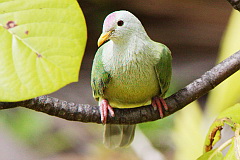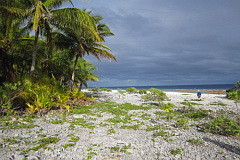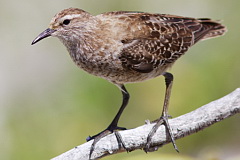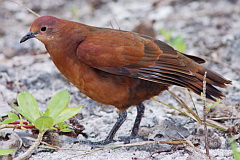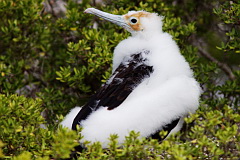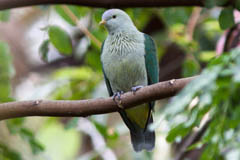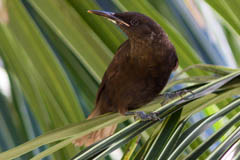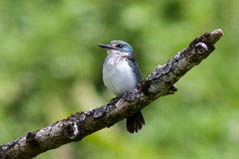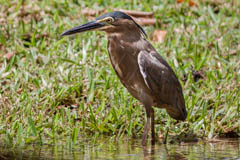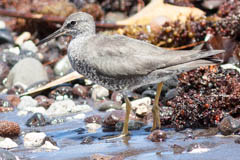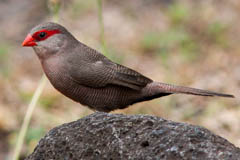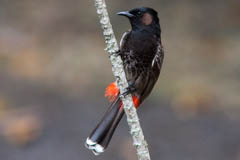This trip report is divided into three parts:
Part 1 - The Pitcairns (Pitcairn, Henderson and Oeno).
Part 2 - The
southern Tuamotus (Teneraro and Morane), Mangareva, Tetiaroa, and Tahiti.
Part 3 - The Marquesas, the northern Tuamotus and Moorea.
Itinerary (Part 2)
12 Sep. Arrived by dawn at Teneraro, where calm in the leeward northern shore. Getting onto the island here was tricky, involving hopping onto exposed rock on top of the reef and wading across the inner lagoon for about 50 metres. Fortunately, the relatively calm conditions made this doable - any large swell would make this landing impossible. A couple of Humpback Whale were patrolling right next to the reef, giving great views, and both Tuamotu Sandpiper and Atoll Fruit Dove were found adjacent to the beach. Finding the Polynesian Ground Dove proved more difficult but one or two found eventually after walking through the coconut plantations and low scrub. To date, the Tuamotu Sandpiper easily made the bird of the trip - an extremely confiding bird that looks like a cross between a crake and a wader, with strange habits of tree-climbing and feeding in flower heads. Good to find that this atoll is still apparently rat-free, which is surprising given that it is covered with coconut palms, planted and harvested by locals living on nearby rat-infested islands. The remainder of the day was spent walking the beach, inner lagoon and plantation edge. Good numbers of Bristle-thighed Curlew, with at least 30 birds. Other species including Black Noddy, Greater Crested Tern, Masked Booby, Red-footed Booby, Pacific Reef Heron and Wandering Tattler. Overnight anchored offshore. 13 Sep. Back to shore with the loose aim of finding a male Polynesian Ground Dove. Unfortunately, a four hour search resulted in not a single sighting of any ground dove. Walking around the understorey here is another test of footwear and balance, with the base coral rock covered in discarded coconuts and spiky fronds from the plentiful Pandanas palms that are great for leg lacerations. Offshore, the Humpback Whale were again giving an extended display. Left the area at 12:30, heading toward Morane. Once out of the lee of Teneraro we were immediately headlong into the southerly swell with our roughest passage to date. A three hour chumming session produced only a few White-faced Storm Petrel and Murphy's Petrel. Due to the strong winds and swell not many takers for dinner. A rough night, reducing the ship's speed. 14 Sep. Arrived at Morane by 07:00, slightly later than planned. Finally out of the heavy seas and into the relative tranquility of the northern shore. The early weather, with strong winds, grey skies and squalls, was more reminiscent of the Norfolk coast than the south Pacific. The transfer to land was decidedly tricky, having to time the swell correctly and jump off onto coral rock, but handled expertly as usual by the crew. A very strong wind and little shelter on the island. Initially we birded the eastern side, which had the greater vegetation, seeing the usual - Tuamotu Sandpiper, Bristle-thighed Curlew, Red-tailed Tropicbird, Masked Booby, Red-footed Booby and Brown Noddy. Not having been cultivated, the vegetation is dense and impenetrable, so looking for Polynesian Ground Dove was not really possible. As this island is rat-free and uninhabited, a walk down the west side gave good numbers of breeding seabirds, particularly Great Frigatebird, Brown Noddy and Red-tailed Tropicbird. Overnight anchored just offshore. 15 Sep. Lifted anchor and headed back toward Mangareva at first light around 06:00. All day in heavy seas and strong winds making it heavy going, with the boat giving a couple of 40° rolls, making life interesting and sending breakfasts everywhere. |
Birding at sea difficult with the deck constantly awash and huge troughs in the waves limiting views of speedily passing Pterodromas - good numbers of Soft-plumaged Petrel throughout the day, but little else. Arrived at Tarovai island, close to Mangareva, around 21:00 - three hours later than planned. A sheltered night just offshore Tarovai.
16 Sep. Headed out to sea to try local chumming. Rather quiet with only a few birds, with the best of the bunch a few Polynesian Storm Petrel and Christmas Shearwater. Mid afternoon returned to Rikitea on Mangareva for customs and immigration formalities. Night in the harbour. Being home, John left us at this time, reducing the crew to four.
17 Sep. Took an early morning walk to the lookout above town, accompanied by one of the local friendly three-and-a-half-legged dogs that seem to attach themselves to visitors and slobber all over them. Pleasant views, but the walk demonstrated just how barren Mangareva is of birds, with absolutely no passerine species - not even of the introduced variety. We temporarily parted company with the Braveheart here, with us returning to Tahiti whilst the ship steamed northward for five days to the Marquesas. Took the ferry from Rikitea to the airfield at 11:00, and 13:30 flight to Papeete, which was delayed 45 minutes. Nearly a four hour direct flight to Tahiti and overnight at the Tahiti Airport Motel.
18 Sep. Having arranged our local guide Philippe Raust, the president of Manu - the BirdLife partner in French Polynesia, ten of us ventured into the Papenoo Valley inside the Parc Natural de Te Faaiti on the northeastern side of the island. Naturally we were seeking the five extant Tahiti endemics, although knowing two of them were difficult to impossible here. Over the course of several hours we recorded a few Grey-green Fruit Dove, Society Kingfisher and Tahiti Reed Warbler, as well as White-tailed Tropicbird, Pacific Black Duck and the very distinctive Tahiti Swallow. The return journey through Papeete town late afternoon was awful, due to heavy rush hour traffic and the open vehicle with parallel benches reminiscent of the jeepneys of the Philippines. The constant stop/go in heavy traffic felt worse than the heavy seas of the boat leg. Hard to imagine such traffic on a peaceful tropical island. 19 Sep. We drove to Papehue on the southwestern side of the island, to the main valley where the Tahiti Monarch conservation program is run, meeting several of the program staff in the small car park at the start of the trail. Access to this valley is restricted, and a $50 conservation fee is payable. In an effort to arrest the decline of the monarch, trapping, baiting and killing of rats, cats, mynas and bulbuls is carried out as well as removing introduced trees and replanting native ones. The current population of the monarch is 41 known birds on established territories with a few young birds thought to wander higher into the mountains. During the previous breeding season ten birds fledged. We climbed up through the forest, crossing the stream a couple of times, for just over a kilometre to arrive at an area where two territories were in close proximity, eventually seeing five Tahiti Monarch. A nearby Tahiti Swiftlet colony was very active with probably a 100 nests. Other species in the area were Society Kingfisher and a couple of Grey-green Fruit Dove. The Tahiti Reed Warbler is absent from this area. From here we proceeded a short distance along the coast to Arahurahu ruins, where the grounds were very pleasant, though held few birds of interest save for further Grey-green Fruit Dove. |
20 Sep. An overcast dreary morning following overnight rain. Having now cleaned up on the Tahiti endemics, and with several members of the group returning home, four of us rented a vehicle and drove the island investigating western and southern parts, simply birding and playing the tourist. A scan from black sand beaches along the western side showed large numbers of, unfortunately distant, seabirds feeding beyond the reef, including Red-footed Booby and scores of Brown Noddy. At Grottes de Maraa we had a single Grey-green Fruit Dove. |
On to Tahiti-iti, that knobbly bit sticking out of the bottom of Tahiti, where we continued to the end of the road at Teahupoo for its world famous surf. To be honest, very disappointing - seen more impressive waves off Brighton pier on an average Sunday. However, the walk along the stony beach, in perfect weather, gave us two Bristle-thighed Curlew, a Little Heron and a Wandering Tattler. A little farther north we stopped at some sewage filter beds adjacent to the main road, finding Pacific Golden Plover, Pacific Reef Heron and a pair of Pacific Black Duck. At another stop en route back to Papeete, a couple of pods of Humpback Whale were feeding offshore. A full contingent of introductions included Red-vented Bubul, Common Myna, Red-browed Firetail, Common Waxbill, Chestnut-breasted Munia, Crimson-backed Tanager and Zebra Dove. Now three weeks into the trip and only four native passerines recorded. And three of them reed warblers!
21 Sep. A day of leisure moving rooms from Tahiti Airport Motel to the more pleasant Fare-Suisse Guesthouse in town.
22 Sep. Joined a standard day trip to the island of Tetiaroa, located 60 kilometres north of Tahiti. A couple of local operators offer these day trips that include snorkeling and a walk on an adjacent, small, rat-free island holding a large number of breeding seabirds. Eight of us, plus a contingent of six French snorkelers The boat was a large catamaran completing the journey in moderate seas in three hours. On the crossing, nearer Moorea, were Tahiti Petrel and Tropical Shearwater. The landing on Tetiaroa, by small motorised dingy, was another technical challenge, requiring riding the incoming swell across the reef. Getting the timing wrong would end up deposited on the live reef, and in deep water - literally. |
After about a kilometre walking the usual rocky coral shoreline we waded across to the small bird island. Several hundred Brown Noddy were lounging around on the sand spit, with small numbers of Red-footed Booby, Sooty Tern and Brown Booby wheeling overhead. A couple of hours walking the shore gave us a singles of Lesser Frigatebird, Great Frigatebird and Red-tailed Tropicbird, together with Greater Crested Tern, Pacific Golden Plover, Wandering Tattler and Common White Tern. On the return we picked up a disappearing tern which looked interesting, and by wading across through deeper water we discovered a small number of breeding Spectacled Tern, offering great photo opportunities and decidedly the bird of the day. Rough passage back to Tahiti, with dinner and beers in the pizzeria near the guesthouse.
Part 1 - The Pitcairns (Pitcairn, Henderson and Oeno).
Part 2 - The
southern Tuamotus (Teneraro and Morane), Mangareva, Tetiaroa, and Tahiti.
Part 3 - The Marquesas, the northern Tuamotus and Moorea.
Galleries
Bird images from this, and other, birding trips.
Travel images from this, and other, birding trips.
Species List (Part 2)
Taxonomy and nomenclature follow IOC World Bird List, version 3.4 (2013). However, a number of highly distinctive regional taxa, that are strong candidates for specific status, are included and indicated by trinomial scientific names.
| Teneraro and its seas | Count | ||
| Murphy's Petrel | Pterodroma ultima | 5 | |
| Cook's Petrel | Pterodroma cookii | 1 | |
| White-faced Storm Petrel | Pelagodroma marina | 2 | |
| Pacific Reef Heron | Egretta sacra | 3 | |
| Great Frigatebird | Fregata minor | 6 | |
| Masked Booby | Sula dactylatra | 8 | |
| Red-footed Booby | Sula sula | 14 | |
| Bristle-thighed Curlew | Numenius tahitiensis | 30 | |
| Wandering Tattler | Tringa incana | 2 | |
| Tuamotu Sandpiper | Prosobonia parvirostris | 50 | |
| Brown Noddy | Anous stolidus | 10 | |
| Black Noddy | Anous minutus | 15 | |
| Common White Tern | Gygis alba | 30 | |
| Greater Crested Tern | Thalasseus bergii | 20 | |
| Polynesian Ground Dove | Pampusana xanthonura | 1 | |
| Atoll Fruit-Dove | Ptilinopus coralensis | 10 | |
| Morane | Count | ||
| Murphy's Petrel | Pterodroma ultima | 10 | |
| Red-tailed Tropicbird | Phaethon rubricauda | 25 | |
| Pacific Reef Heron | Egretta sacra | 2 | |
| Great Frigatebird | Fregata minor | 25 | |
| Lesser Frigatebird | Fregata ariel | 1 | |
| Masked Booby | Sula dactylatra | 10 | |
| Red-footed Booby | Sula sula | 15 | |
| Bristle-thighed Curlew | Numenius tahitiensis | 3 | |
| Wandering Tattler | Tringa incana | 1 | |
| Tuamotu Sandpiper | Prosobonia parvirostris | 40 | |
| Brown Noddy | Anous stolidus | 50 | |
| Common White Tern | Gygis alba | 12 | |
| Greater Crested Tern | Thalasseus bergii | 6 | |
| Tahiti | Count | ||
| Tahiti Petrel | Pseudobulweria rostrata | 20 | |
| Tropical Shearwater | Puffinus bailloni | 5 | |
| Swamp Harrier | Circus approximans | 6 | |
| Pacific Golden Plover | Pluvialis fulva | 2 | |
| Bristle-thighed Curlew | Numenius tahitiensis | 2 | |
| Wandering Tattler | Tringa incana | 1 | |
| Brown Noddy | Anous stolidus | 25 | |
| Common White Tern | Gygis alba | 12 | |
| Greater Crested Tern | Thalasseus bergii | 12 | |
| Grey-green Fruit Dove | Ptilinopus purpuratus | 8 | |
| Society Kingfisher | Todiramphus veneratus | 14 | |
| Tahiti Monarch | Pomarea nigra | 5 | |
| Tahiti Swallow | Hirundo tahitica | 7 | |
| Tahiti Reed Warbler | Acrocephalus caffer | 10 | |
| Common Waxbill | Estrilda astrild | 25 | |
| Red-browed Firetail | Emblema temporalis | 2 | |
| Chestnut-breasted Munia | Lonchura castaneothorax | 4 | |
| Crimson-backed Tanager | Ramphocelus dimidiatus | 6 | |
| Tetiaroa | Count | ||
| Red-tailed Tropicbird | Phaethon rubricauda | 1 | |
| White-tailed Tropicbird | Phaethon lepturus | 1 | |
| Pacific Reef Heron | Egretta sacra | 2 | |
| Great Frigatebird | Fregata minor | 1 | |
| Lesser Frigatebird | Fregata ariel | 1 | |
| Red-footed Booby | Sula sula | 40 | |
| Brown Booby | Sula leucogaster | 10 | |
| Pacific Golden Plover | Pluvialis fulva | 2 | |
| Wandering Tattler | Tringa incana | 2 | |
| Brown Noddy | Anous stolidus | 4,000 | |
| Common White Tern | Gygis alba | 10 | |
| Greater Crested Tern | Thalasseus bergii | 60 | |
| Spectacled Tern | Onychoprion lunatus | 10 | |
| Sooty Tern | Onychoprion fuscatus | 20 |

